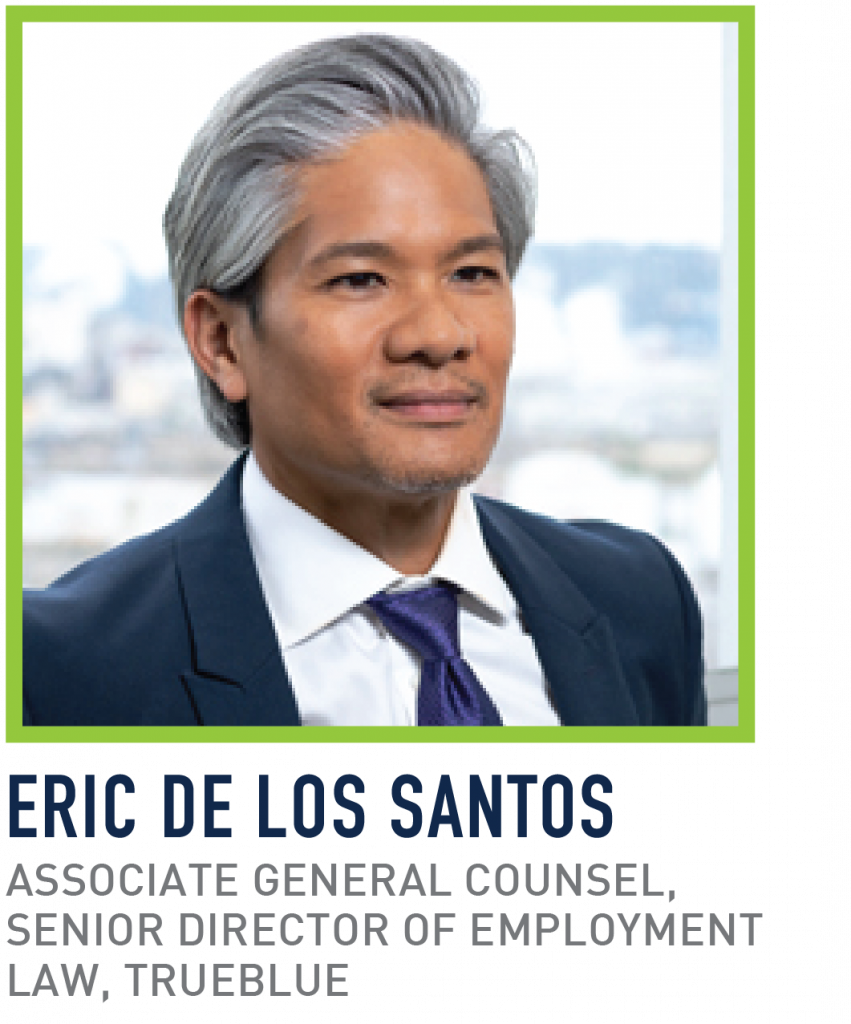
The expertise and passion that Eric de los Santos has for diversity and inclusion was forged from his life experiences. As the first in his family to receive a university education, he left his home state of Hawaii to attend Brown University on scholarship and went on to receive his law degree from the University of Washington. Eric joined PeopleScout’s parent company, TrueBlue, 15 years ago; he’s currently the Associate General Counsel, Senior Director of Employment Law, while also serving as President of the National Filipino Lawyers Association. Eric was also the first Chair of the Diversity and Inclusion Council at TrueBlue.
An avid gardener, de los Santos likes to compare a diverse and inclusive workplace to a garden with multiple varieties of plants that thrive only when the proper nutrients and level of care are provided. He shared his insightful perspectives at PeopleScout’s 2019 NEXT Talent Summit in June, where he hosted a Big Idea Talk and breakout session entitled “Authenticity and Tending to the Garden of Realness.” Before his talk, Eric sat down with us to share his thoughts on diversity and inclusion in the workplace.
The terms diversity and inclusion are often linked in the corporate context. How do these concepts differ and how do they complement each other?
I liken the concept of diversity and inclusion to a garden. Diversity can be thought of as the different species and varieties of plants, while inclusion is the environment that ensures that each and every plant can grow and flourish. Some plants may have special requirements, like the type of soil to use or how much they need to be watered. Inclusion in the garden means nurturing all of the different plants and giving each one exactly what it needs to thrive.
Applying this analogy to a company, management’s role is to provide every employee with what is needed to grow and flourish. And, because these elements may differ for every employee, it can be very challenging. However, just like a beautiful garden that is bursting with different varieties, the result will be a company that is filled with people from many backgrounds who display their full potential and contribute to its success.
So, having a diverse and inclusive workplace can be a decisive factor in a company’s success?
Yes. Take the example of two groups. One group is comprised of people from a single background and culture, while the second group is comprised of multiple backgrounds and cultures. Studies have shown that, when confronted with a problem, the group with diverse backgrounds not only comes up with a greater number of solutions, but their solutions are far more creative and likely to succeed. The diverse group is also more likely to anticipate problems that may arise in the future because it is not limited by the “blind spots” arising from the limited experience and outlook of the monolithic group.
Dig Deeper
PeopleScout Webinar: Using Data to Optimize Your Recruiting Process and Employer Brand
A company that can successfully bring diverse people together – to share ideas on how to improve performance or create a better company – will have a clear competitive advantage over one that cannot. It is vital that all of those who participate in these discussions feel that they can honestly share their ideas without fear and in an environment of mutual respect.
The crucial factor is to enable everyone to be their authentic selves, not to feel compelled to hide a part of themselves as they interact with others. Employees who are inhibited from displaying who they truly are may look for the exit at the first opportunity. In contrast, those who can be their authentic selves at work are motivated to contribute to an enterprise that recognizes and respects them. Rather than being inhibited, an inclusive environment can result in a workforce that does not hold back from contributing ideas and puts in the hard work that can drive a company’s success.
How did your life experience lead you to become passionate about diversity and inclusion and eventually start the Diversity and Inclusion Council at TrueBlue?
Growing up in Hawaii, I was surrounded by people from many different backgrounds and cultures, which people discussed with great ease. When I came to the mainland to study, I noticed that there was a tendency for people to compartmentalize themselves – to reveal only the parts that would be readily accepted by others and to keep parts hidden. As a Filipino-American and a gay man, no matter where life took me, I had a feeling of being different. But, I saw no reason why my differences should function as barriers. I learned firsthand about the issues of bias in American life, and ultimately, I understood that bias was something that needed to be confronted and challenged.
After years of working as a trial lawyer, I joined the predecessor of TrueBlue as a corporate counsel in 2004. Shortly after joining the company, I was invited to an outing that included spouses and significant others. I brought the man who is now my husband, and introduced him as my boyfriend to my coworkers. While this may not seem particularly noteworthy in 2019, being openly gay at work was much less common then. Introducing him as my boyfriend clearly had an influence on many people that night because they congratulated me for openly introducing our relationship. From that point forward, an important part of who I am was no longer hidden from my colleagues.
What were your first steps in establishing the Diversity and Inclusion Council and how has it developed over time?
I found that there was a great interest in diversity and inclusion issues in the company, and I worked to start conversations around the topic. When the Diversity and Inclusion Council was started in 2012, I was asked to be its first chairman.
From the outset, we took steps to make sure that the council had a lasting foundation and that everyone could be engaged in the process. It was also important that we presented diversity as not just being about who we are on the outside; it’s about everything that makes us who we are. We created training programs for managers and exercises to help people talk about themselves, their backgrounds and all of the parts that comprise their whole, authentic self.
The council’s programs were very popular and continue to be engaging today. There was a lot of excitement around these conversations, which provided opportunities to build greater trust and openness within the company. Building on this momentum, we created a comprehensive program that includes employee resource groups such as Women in Leadership, the African-American Resource Network and an LGBTQ group, called BE PROUD. The groups are still expanding and will include groups for Latinx and Hispanic employees, as well as a veterans resource group. The council has also been pursuing initiatives and programs to engage TrueBlue’s contingent workforce, and is focusing on developing a pipeline of future leaders.
What are your thoughts about the role of leadership in diversity and inclusion?
It’s critical that leaders understand their workforce and take steps to deepen that understanding. Even something as mundane as a departmental potluck lunch can be an opportunity to learn more about your team. For example, instead of telling people to bring whatever dish they want, ask them to bring something from their culture or background, and write a short piece explaining why they chose that dish and its significance.
While this is an example of a useful exercise, being able to respond positively to the needs of your workforce goes well beyond understanding their cultural backgrounds. Take the initiative to find out whether there are any issues going on in their lives outside of the confines of the workplace, and see if you can respond to their needs. For example, if an employee is struggling to take care of an elderly relative who needs help while they are at work, offer them flexibility in their work schedule. This outreach creates an environment of mutual understanding and support.
It is also important that leaders “walk the talk” of diversity and inclusion to be open and authentic themselves. No one is perfect, and everyone has biases and preconceived notions that need to be challenged. Some people find it difficult to talk about certain issues of identity or diversity. It’s fine to acknowledge this and work to find the right words to use that reflect both acceptance and respect. Our employees want to see us as people with real lives that they can relate to. Each one of us has the opportunity to stand out in a unique way.
Finally, every leader should have a sense of responsibility to foster and nurture a genuinely inclusive environment. To return to the analogy of the garden, as leaders we have the responsibility to ensure our work environment allows people to be their authentic selves – we are the ones who are tending to the garden of realness.
![[Webinar] Smart Hiring in the AI Age: What UK Candidates Are Really Doing in 2025](https://www.peoplescout.com/wp-content/uploads/2025/05/AI-enable-applicant-report-320x320.jpg)
